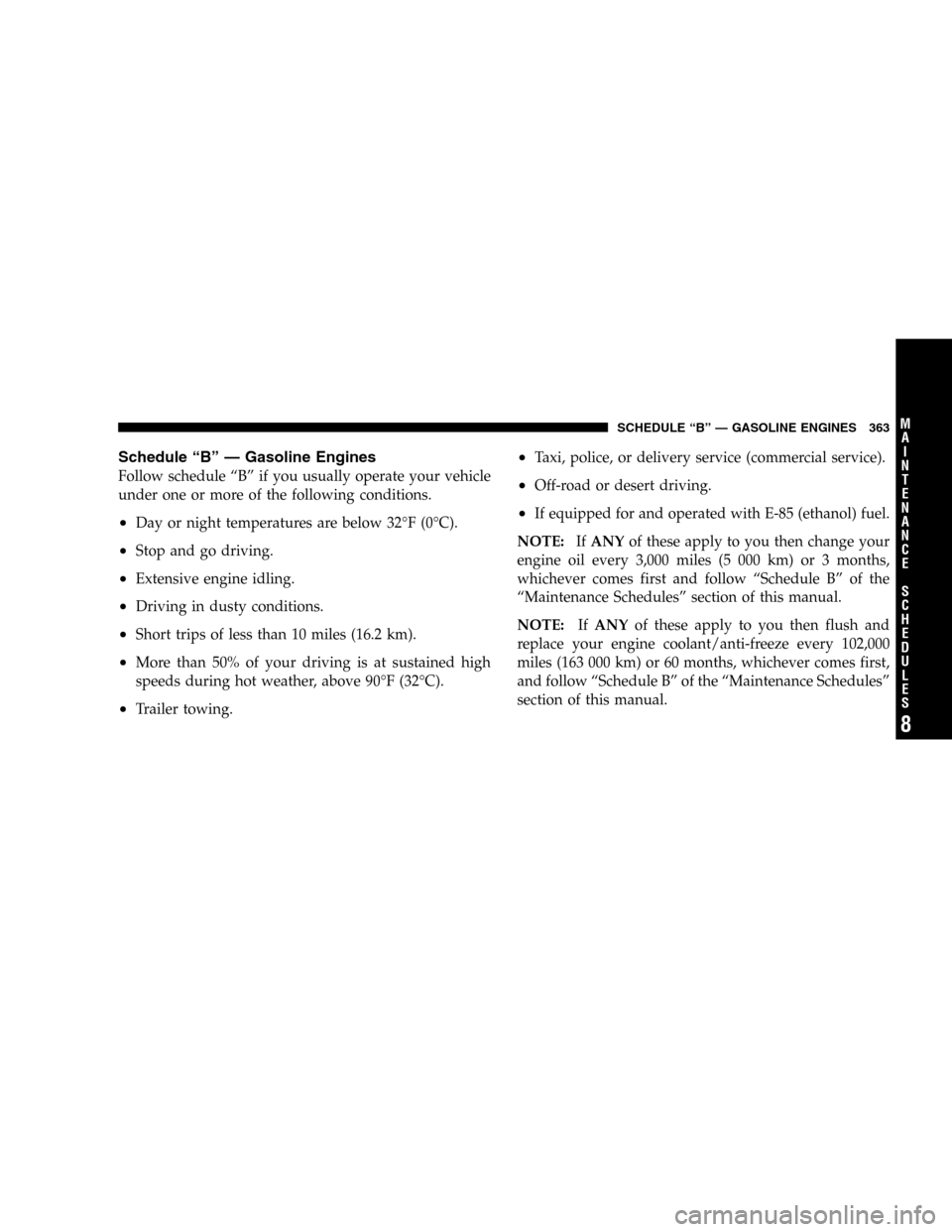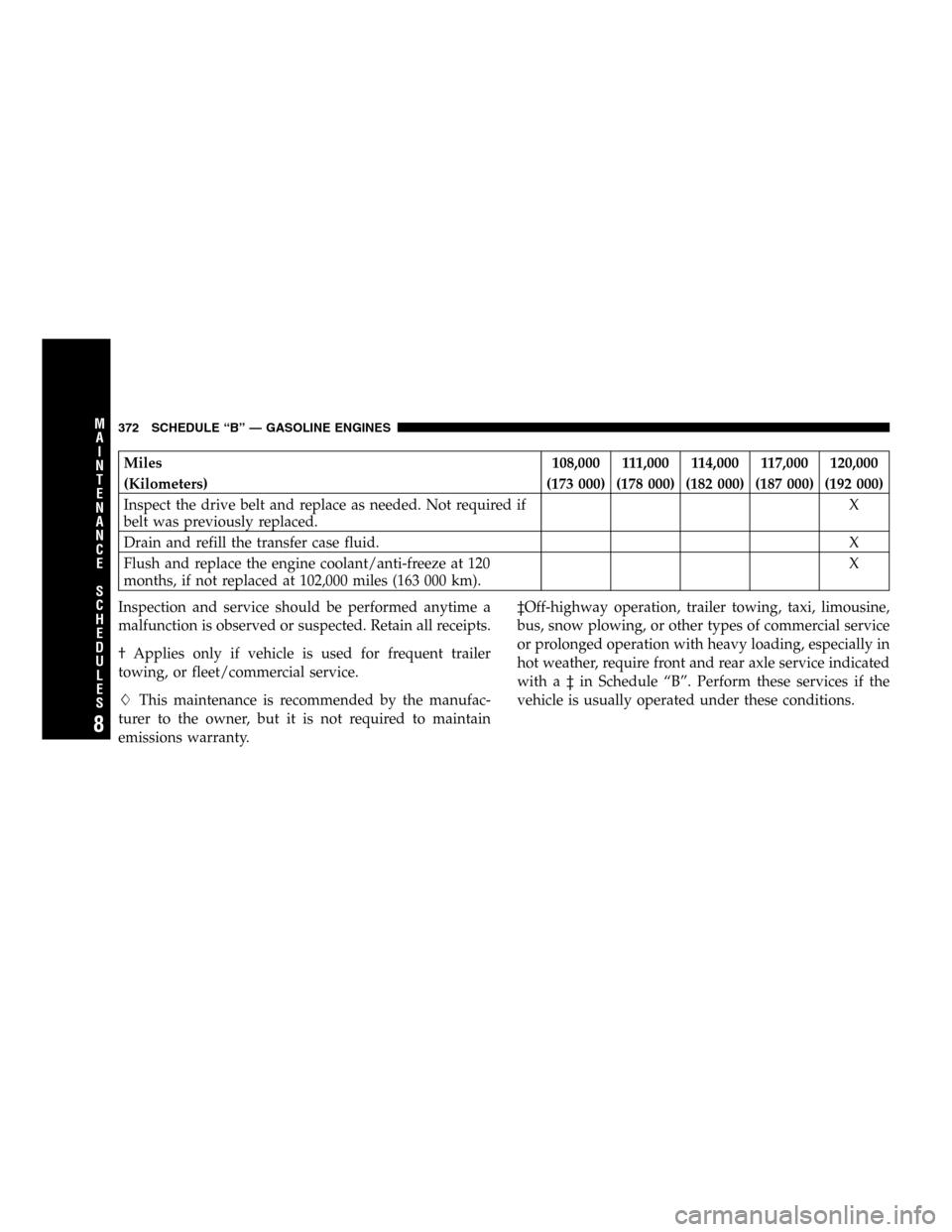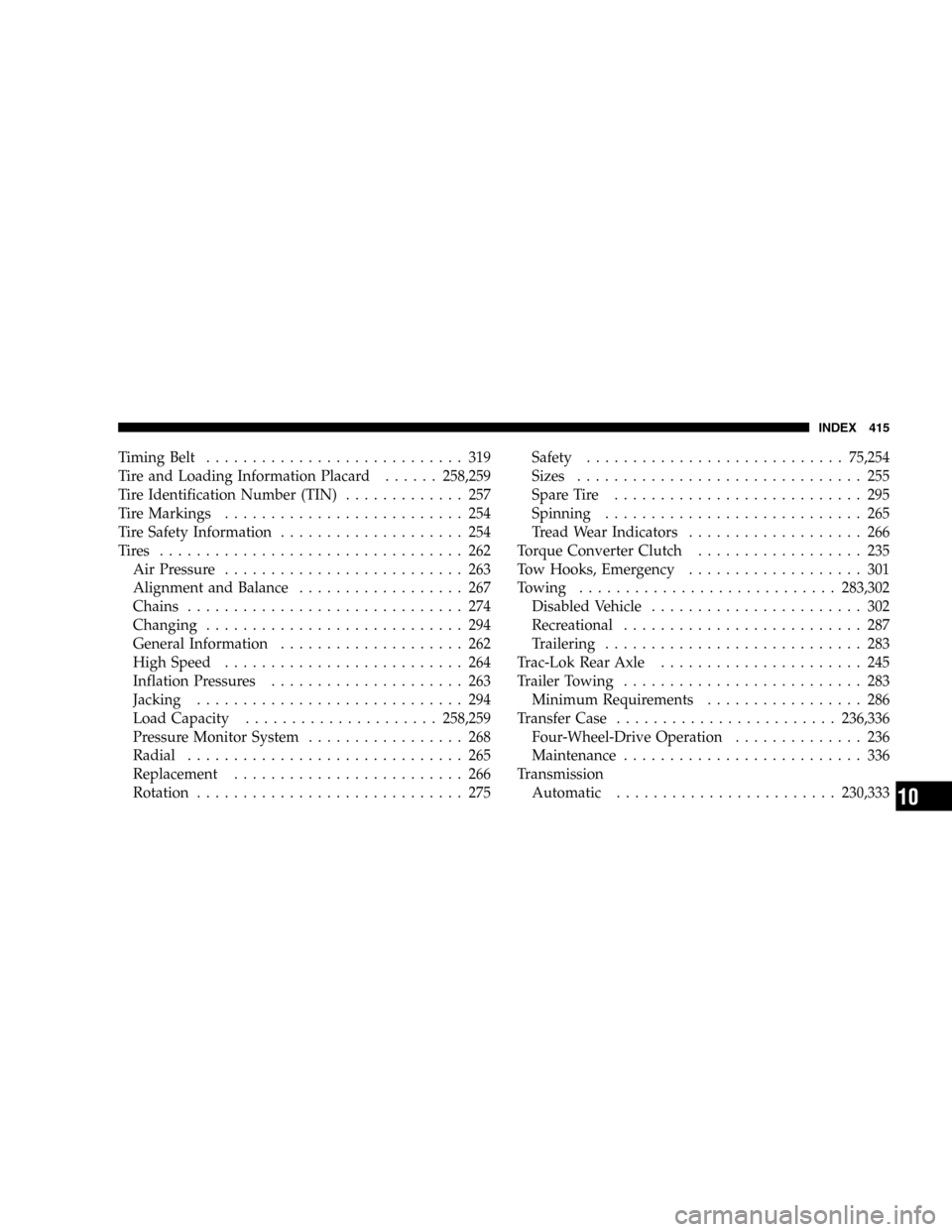Page 360 of 424

EMISSION CONTROL SYSTEM MAINTENANCE
The “Scheduled” maintenance services, listed inbold
typemust be done at the times or mileages specified to
assure the continued proper functioning of the emission
control system. These, and all other maintenance services
included in this manual, should be done to provide best
vehicle performance and reliability. More frequent main-
tenance may be needed for vehicles in severe operating
conditions such as dusty areas and very short trip
driving.
Inspection and service also should be done any time a
malfunction is suspected.
NOTE:Maintenance, replacement, or repair of the emis-
sion control devices and systems on your vehicle may be
performed by any automotive repair establishment or
individual using any automotive part which has been
certified pursuant to U.S. EPA or, in the State of Califor-
nia, California Air Resources Board regulations.
MAINTENANCE SCHEDULES — GASOLINE
ENGINES
There are two maintenance schedules that show the
requiredservice for your vehicle.
First is Schedule�B�. It is for vehicles that are operated
under the conditions that are listed below and at the
beginning of the schedule.
•Day or night temperatures are below 32°F (0°C).
•Stop and go driving.
•Extensive engine idling.
•Driving in dusty conditions.
•Short trips of less than 10 miles (16.2 km).
•More than 50% of your driving is at sustained high
speeds during hot weather, above 90°F (32°C).
•Trailer towing.
360 MAINTENANCE SCHEDULES
8
M
A
I
N
T
E
N
A
N
C
E
S
C
H
E
D
U
L
E
S
Page 363 of 424

Schedule “B” — Gasoline Engines
Follow schedule “B” if you usually operate your vehicle
under one or more of the following conditions.
•Day or night temperatures are below 32°F (0°C).
•Stop and go driving.
•Extensive engine idling.
•Driving in dusty conditions.
•Short trips of less than 10 miles (16.2 km).
•More than 50% of your driving is at sustained high
speeds during hot weather, above 90°F (32°C).
•Trailer towing.
•Taxi, police, or delivery service (commercial service).
•Off-road or desert driving.
•If equipped for and operated with E-85 (ethanol) fuel.
NOTE:IfANYof these apply to you then change your
engine oil every 3,000 miles (5 000 km) or 3 months,
whichever comes first and follow “Schedule B” of the
“Maintenance Schedules” section of this manual.
NOTE:IfANYof these apply to you then flush and
replace your engine coolant/anti-freeze every 102,000
miles (163 000 km) or 60 months, whichever comes first,
and follow “Schedule B” of the “Maintenance Schedules”
section of this manual.
SCHEDULE “B” — GASOLINE ENGINES 363
8
M
A
I
N
T
E
N
A
N
C
E
S
C
H
E
D
U
L
E
S
Page 372 of 424

Miles 108,000 111,000 114,000 117,000 120,000
(Kilometers) (173 000) (178 000) (182 000) (187 000) (192 000)
Inspect the drive belt and replace as needed. Not required if
belt was previously replaced.X
Drain and refill the transfer case fluid. X
Flush and replace the engine coolant/anti-freeze at 120
months, if not replaced at 102,000 miles (163 000 km).X
Inspection and service should be performed anytime a
malfunction is observed or suspected. Retain all receipts.
† Applies only if vehicle is used for frequent trailer
towing, or fleet/commercial service.
This maintenance is recommended by the manufac-
turer to the owner, but it is not required to maintain
emissions warranty.‡Off-highway operation, trailer towing, taxi, limousine,
bus, snow plowing, or other types of commercial service
or prolonged operation with heavy loading, especially in
hot weather, require front and rear axle service indicated
witha‡inSchedule “B”. Perform these services if the
vehicle is usually operated under these conditions.
372 SCHEDULE “B” — GASOLINE ENGINES
8
M
A
I
N
T
E
N
A
N
C
E
S
C
H
E
D
U
L
E
S
Page 378 of 424

MAINTENANCE SCHEDULES — DIESEL ENGINES
There are two maintenance schedules that show the
requiredservice for your vehicle.
First is Schedule�B�. It is for vehicles that are operated
under the conditions that are listed below and at the
beginning of the schedule.
•Day or night temperatures are below 32°F (0°C).
•Stop and go driving.
•Extensive engine idling.
•Driving in dusty conditions.
•Short trips of less than 10 miles (16.2 km).
•More than 50% of your driving is at sustained high
speeds during hot weather, above 90°F (32°C).
•Trailer towing.
•Taxi, police, or delivery service (commercial service).
•Off-road or desert driving.
NOTE:Most vehicles are operated under the conditions
listed for Schedule “B.”
Second is Schedule“A”. It is for vehicles that are not
operated under any of the conditions listed under Sched-
ule “B.”
Use the schedule that best describes your driving condi-
tions. Where time and mileage are listed, follow the
interval that occurs first.
CAUTION!
Failure to perform the required maintenance items
may result in damage to the vehicle.
378 SCHEDULE “A” — GASOLINE ENGINES
8
M
A
I
N
T
E
N
A
N
C
E
S
C
H
E
D
U
L
E
S
Page 380 of 424
Schedule “B” — Diesel Engines
Follow schedule “B” if you usually operate your vehicle
under one or more of the following conditions.
•Day or night temperatures are below 32°F (0°C).
•Stop and go driving.
•Extensive engine idling.
•Driving in dusty conditions.
•Short trips of less than 10 miles (16.2 km).
•More than 50% of your driving is at sustained high
speeds during hot weather, above 90°F (32°C).
•Trailer towing.
•Taxi, police, or delivery service (commercial service).
•Off-road or desert driving.
380 SCHEDULE “B” — DIESEL ENGINES
8
M
A
I
N
T
E
N
A
N
C
E
S
C
H
E
D
U
L
E
S
Page 384 of 424
Miles 68,750 75,000 81,250 87,500 93,750 100,000
(Kilometers) (110 000) (120 000) (130 000) (140 000) (150 000) (160 000)
Inspect the brake linings. X X
Drain and refill the front and rear axle fluid. X X
Applies only if vehicle is used for frequent trailer
towing, or fleet/commercial service.
† The replacement of such component is requested if
there is superficial wear, bearing clearance, or evident
grease leak.Inspection and service should be performed anytime a
malfunction is observed or suspected. Retain all receipts.
384 SCHEDULE “B” — DIESEL ENGINES
8
M
A
I
N
T
E
N
A
N
C
E
S
C
H
E
D
U
L
E
S
Page 415 of 424

Timing Belt............................ 319
Tire and Loading Information Placard......258,259
Tire Identification Number (TIN)............. 257
Tire Markings.......................... 254
Tire Safety Information.................... 254
Tires ................................. 262
Air Pressure.......................... 263
Alignment and Balance.................. 267
Chains.............................. 274
Changing............................ 294
General Information.................... 262
High Speed.......................... 264
Inflation Pressures..................... 263
Jacking............................. 294
Load Capacity.....................258,259
Pressure Monitor System................. 268
Radial.............................. 265
Replacement......................... 266
Rotation............................. 275Safety............................75,254
Sizes............................... 255
Spare Tire........................... 295
Spinning............................ 265
Tread Wear Indicators................... 266
Torque Converter Clutch.................. 235
Tow Hooks, Emergency................... 301
Towing............................283,302
Disabled Vehicle....................... 302
Recreational.......................... 287
Trailering............................ 283
Trac-Lok Rear Axle...................... 245
Trailer Towing.......................... 283
Minimum Requirements................. 286
Transfer Case........................236,336
Four-Wheel-Drive Operation.............. 236
Maintenance.......................... 336
Transmission
Automatic........................230,333
INDEX 415
10
Page:
< prev 1-8 9-16 17-24